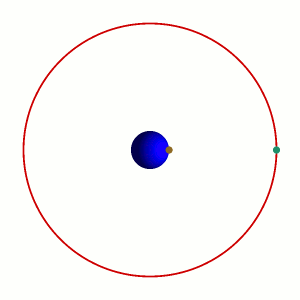Communications satellite
(Redirected from Satellite communications)
Communications satellite is an artificial satellite stationed in space for the purposes of telecommunications. Modern communications satellites use geosynchronous orbits, Molniya orbits, or low Earth orbits to provide communication services to different areas on Earth. These satellites are capable of relaying data, voice, TV, and radio signals between ground stations that are located vast distances apart, making global communication instantaneously possible.
History[edit | edit source]
The concept of a communications satellite was first proposed by Arthur C. Clarke in 1945. However, it wasn't until 1960 that the first communications satellite, Echo 1, was launched by NASA. Echo 1 was a passive satellite, merely reflecting radio signals sent from one point on Earth to another. The first active communications satellite, which could receive, amplify, and transmit signals, was Telstar 1, launched in 1962.
Types of Communications Satellites[edit | edit source]
Communications satellites can be classified based on their orbits:
- Geosynchronous Orbits (GEO): Satellites in these orbits appear to be stationary from any point on Earth, making them ideal for TV and radio broadcasting, as well as communication services.
- Molniya Orbits: These highly elliptical orbits are suited for providing coverage to high-latitude regions, where geosynchronous satellites are less effective.
- Low Earth Orbits (LEO): Satellites in LEO are closer to Earth, reducing transmission delay. They are used for mobile voice and data communications, including satellite phones and global positioning systems.
Technology[edit | edit source]
Communications satellites carry a variety of transponders that relay signals. These satellites are equipped with antennas and solar panels, and they utilize onboard propulsion systems to maintain their orbits. The technology behind satellite communication involves the transmission of signals to the satellite (uplink), amplification or repeation of these signals by the satellite, and then sending them back to Earth (downlink).
Applications[edit | edit source]
The applications of communications satellites are vast and include:
- Broadcasting: Satellite television and radio broadcasting is one of the most common uses, enabling direct-to-home (DTH) broadcasting and satellite radio services.
- Telephony: Satellite phones provide communication capabilities in remote areas where terrestrial cell networks are unavailable.
- Internet Access: Satellites offer broadband internet in remote locations, often used in maritime, aviation, and rural applications.
- Military Communications: Satellites provide secure and reliable communication links for military operations, including mobile command, control, communications, computers, intelligence, surveillance, and reconnaissance (C4ISR) systems.
Future Trends[edit | edit source]
The future of communications satellites includes the development of mega-constellations of small satellites in LEO, designed to provide global broadband coverage. Companies like SpaceX with its Starlink project, and OneWeb, are leading this initiative. Additionally, advancements in satellite technology, such as higher throughput capabilities and laser communication links, promise to enhance the efficiency and speed of satellite communications.
Search WikiMD
Ad.Tired of being Overweight? Try W8MD's physician weight loss program.
Semaglutide (Ozempic / Wegovy and Tirzepatide (Mounjaro / Zepbound) available.
Advertise on WikiMD
|
WikiMD's Wellness Encyclopedia |
| Let Food Be Thy Medicine Medicine Thy Food - Hippocrates |
Translate this page: - East Asian
中文,
日本,
한국어,
South Asian
हिन्दी,
தமிழ்,
తెలుగు,
Urdu,
ಕನ್ನಡ,
Southeast Asian
Indonesian,
Vietnamese,
Thai,
မြန်မာဘာသာ,
বাংলা
European
español,
Deutsch,
français,
Greek,
português do Brasil,
polski,
română,
русский,
Nederlands,
norsk,
svenska,
suomi,
Italian
Middle Eastern & African
عربى,
Turkish,
Persian,
Hebrew,
Afrikaans,
isiZulu,
Kiswahili,
Other
Bulgarian,
Hungarian,
Czech,
Swedish,
മലയാളം,
मराठी,
ਪੰਜਾਬੀ,
ગુજરાતી,
Portuguese,
Ukrainian
Medical Disclaimer: WikiMD is not a substitute for professional medical advice. The information on WikiMD is provided as an information resource only, may be incorrect, outdated or misleading, and is not to be used or relied on for any diagnostic or treatment purposes. Please consult your health care provider before making any healthcare decisions or for guidance about a specific medical condition. WikiMD expressly disclaims responsibility, and shall have no liability, for any damages, loss, injury, or liability whatsoever suffered as a result of your reliance on the information contained in this site. By visiting this site you agree to the foregoing terms and conditions, which may from time to time be changed or supplemented by WikiMD. If you do not agree to the foregoing terms and conditions, you should not enter or use this site. See full disclaimer.
Credits:Most images are courtesy of Wikimedia commons, and templates, categories Wikipedia, licensed under CC BY SA or similar.
Contributors: Prab R. Tumpati, MD


